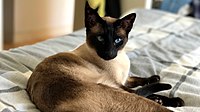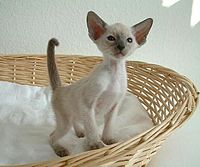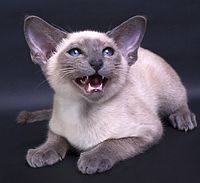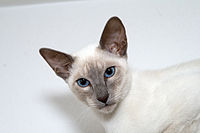Siamese cat
| Siamese cat | |
|---|---|
 Lilac-point Siamese (Oriental) | |
| Common nicknames | Meezer, Mese, Sagwa |
| Origin | Thailand |
| Breed standards | |
| CFA | standard |
| FIFe | standard |
| TICA | standard |
| ACF | standard |
| ACFA/CAA | standard |
| CCA-AFC | standard |
| GCCF | standard |
| Domestic cat (Felis catus) | |
The Siamese cat (Thai: แมวไทย, Maeo Thai; แมวสยาม, Maeo Sayam) is one of the first distinctly recognised breeds of Asian cat. It derives from the Wichianmat landrace. The Siamese cat is one of several varieties of cats native to Thailand (known as Siam before 1939). The original Siamese became one of the most popular breeds in Europe and North America in the 19th century.[1] Siamese cats have a distinctive colourpoint coat, resulting from a temperature-sensitive type of albinism.
Distinct features like blue almond-shaped eyes, a triangular head shape, large ears, an elongated, slender, and muscular body, and various forms of point colouration characterise the modern-style Siamese. The modern-style Siamese's point-colouration resembles the "old-style" foundation stock. The "old-style" Siamese have a round head and body. They have been re-established by multiple registries as the Thai cat. Siamese and Thai cats are selectively bred and pedigreed in multiple cat fancier and breeder organisations. The terms "Siamese" or "Thai" are used for cats from this specific breed, which are by definition all purebred cats with a known and formally registered ancestry. The ancestry registration is the cat's pedigree or "paperwork".[2][3]
The Siamese is a part of the foundation stock for crossbreeding with other cats. The crossbreeding resulted in many different types of cats, like the Oriental Shorthair and Colourpoint Shorthair. The Oriental Shorthair and Colourpoint Shorthair were developed to expand the range of coat patterns. The breeding of the Oriental and Colourpoint Shorthairs resulted in a long-haired variant called the Himalayan. The long-haired Siamese is recognised internationally as a Balinese cat. The breeding also created the hair-mutation breeds, including the Cornish Rex, Sphynx, Peterbald, and blue-point Siamese cat.
History
[edit]
Origins
[edit]Thailand
[edit]A description and depiction of the Wichianmat (Siamese cat) first appears in a collection of ancient manuscripts called the Tamra Maew (The Cat-Book Poems), thought to originate from the Ayutthaya Kingdom (1351 to 1767 AD). Over a dozen are now kept in the National Library of Thailand. The manuscripts have resurfaced outside of Thailand and are now in the British Library and National Library of Australia.
At the end of the Burmese–Siamese war, the capitol was sacked on 7 April 1767. The Burmese army burned everything in sight and returned to Burma, taking Siamese noblemen and royal family members with them as captives. A Thai legend states that the King of Burma Hsinbyushin found and read the poem for the Thai cats in the Tamra Maew. The poem describes Thai cats as being as rare as gold, and anyone who owns this cat will become wealthy. He told his army to round up all the Suphalak cats and bring them back to Burma along with the other treasures. Today in Thailand, people tell this legend as a humorous explanation of the rarity of Thai cats.[4]
Siamese
[edit]The pointed cat known in the West as "Siamese", recognised for its distinctive markings, is one of several breeds of cats from Siam described and illustrated in manuscripts called "Tamra Maew" (Cat Poems). The "Tamra Maew" is estimated to have been written from the 14th to the 18th century.[5] In 1878, U.S. President Rutherford B. Hayes received the first documented Siamese to reach the United States. The cat, named "Siam," was sent from Bangkok to the American Consul. [6] In 1884, the British Consul-General in Bangkok, Edward Blencowe Gould (1847–1916),[7] brought a breeding pair of the cats, Pho and Mia, back to Britain as a gift for his sister, Lilian Jane Gould (who, married in 1895 as Lilian Jane Veley,[8] went on to co-found the Siamese Cat Club in 1901). In 1885, Gould's UK cats Pho and Mia produced three Siamese kittens—Duen Ngai, Kalohom, and Khromata—who were shown with their parents that same year at London's Crystal Palace Show. Their appearance and behaviour attracted attention, but all three of the kittens died soon after the show, their cause of death not documented.[9]
By 1886, four Siamese cats were imported to the UK by Eva Forestier Walker (surnamed Vyvyan after 1887 marriage)[10] and her sister, Ada. These Siamese imports were long, had rounded heads with wedge-shaped muzzles, and large ears [citation needed]. The cats ranged from substantial to slender but were not either extreme.[citation needed] The difference in the pointed coat pattern had not been seen before in cats by Westerners.[citation needed] Over the next several years, fanciers imported a small number of cats, forming the base breeding pool for the entire breed in Britain. It is believed that most Siamese in Britain today are descended from about eleven of these original imports. In Britain, they were called the "Royal Cat of Siam." Some reports say that they had previously been kept only by Siamese royalty.[11] Research does not show evidence of any organised royal breeding programme in Siam.[5]
-
King Prajadhipok following his coronation day, surrounded by the court ladies carrying his regalia and what is today regarded as a Thai cat, the cat symbolises "domesticity".
-
Wankee, born in 1895 in Hong Kong, became the first UK Siamese champion in 1898.
-
While this show quality specimen from 1960 still exhibits relatively moderate characteristics, the breed standard was setting the stage for the modern Siamese, with its call for a "dainty, long and svelte" body, a long head that "taper[s] in straight lines from the ears to a narrow muzzle", "ears large and pricked, wide at the base" and tail "long and tapering".
-
A classic seal point Siamese prize winner. Note the darker colours at the extremes, e.g. face/ears, tail and legs.
Traditional Siamese versus modern development
[edit]In the 1950s–1960s, as the Siamese was increasing in popularity, many breeders and cat show judges began to favour the more slender look. Breeders created increasingly long, fine-boned, narrow-headed cats through generations of selective breeding. Eventually, the modern show Siamese was bred to be extremely elongated, with a lean, tubular body, long, slender legs, a very long, very thin tail that tapers gradually into a point, and a long, wedge-shaped head topped by extremely large, wide-set ears.[citation needed]
By the mid-1980s, cats of the original style had largely disappeared from cat shows. Still, a few breeders, particularly in the UK, continued to breed and register them, resulting in today's two types of Siamese: the modern, "show-style", standardised Siamese, and the "Traditional Siamese", both descended from the same distant ancestors, but with few or no recent ancestors in common, and effectively forming distinct sub-breeds, with some pressure to separate them.[citation needed]
In addition to the modern Siamese breed category, The International Cat Association (TICA) and the World Cat Federation (WCF) now accept Siamese cats of the less extreme type, and any wichianmat cat imported directly from Thailand, under the new breed name Thai.[12][13] Other, mostly unofficial, names for the traditional variety are "Old-style Siamese" and "Classic Siamese", with an American variation nicknamed "Applehead".[14][15]
-
Traditional "applehead" Thai cat
-
Traditional seal point Thai cat
-
Traditional seal point Thai cat with a round head and a bulky-build body
-
Modern seal point Siamese cat (side view) with a slim "wedge head" and a slender-build body
-
Modern "wedge head" seal point Siamese cat
-
Modern seal point Siamese cat (front view) with extremely large, wide-set ears
Appearance
[edit]
The breed standard of the modern Siamese calls for an elongated, tubular, and muscular body and a triangular head, forming a triangle from the tip of the nose to each tip of the ear. The eyes are almond-shaped and light blue, while the ears are large, wide-based, and positioned more towards the side of the head. The breed has a long neck, a slender tail, and fur that is short, glossy, fine and adheres to the body with no undercoat. Its pointed colour scheme and blue eyes distinguish it from the closely related Oriental Shorthair. The modern Siamese shares the pointed colour pattern with the Thai, or traditional Siamese, but they differ in head and body type.
The pointed pattern is a form of partial albinism, resulting from a mutation in tyrosinase, an enzyme involved in melanin production. The mutated tyrosinase enzyme is heat-sensitive; it fails to work at normal body temperatures but becomes active in cooler (< 33 °C) areas of the skin.[16] The heat-sensitive enzyme results in a dark colouration in the coolest parts of the cat's body, like the extremities and the face, which are cooled by the airflow through their sinuses. Siamese kittens are cream or white at birth and develop visible points in the first few months of life in colder parts of their body.[17] By the time a kitten is four weeks old, the points should be sufficiently distinguishable to recognise which colour they are.[citation needed]
Siamese cats tend to darken with age, and generally, adult Siamese living in warm climates have lighter coats than those in cool climates. Originally the vast majority of Siamese had seal (extremely dark brown, almost black) points, but occasionally Siamese was born with "blue" (a cool grey) points, genetically a dilution of seal point; chocolate (lighter brown) points, a genetic variation of seal point; or lilac (pale warm grey) points, genetically a diluted chocolate. These colours were considered "inferior" seal points and were not qualified for showing or breeding. These shades were eventually accepted by the breed associations and became more common through breeding programmes specifically aimed at producing these colours. Later, outcrosses with other breeds developed Siamese-mix cats with points in other cat colours and patterns, including red and cream points, lynx (tabby) points, and tortoise-shell ("tortie") points. [citation needed]
In the United Kingdom, all pointed Siamese-style cats are considered part of the Siamese breed.[citation needed] The Cat Fanciers' Association, considers only the four original fur colours as Siamese:
- seal point,
- blue point,
- the chocolate point, and
- lilac point.[18]
Oriental Shorthair cats with colour points in colours or patterns aside from these four are considered Colourpoint Shorthair in that registry. The World Cat Federation has also adopted this classification, treating the Colourpoint Shorthair as a distinct breed.[13]
Many Siamese cats from Thailand had a kink in their tails, but over the years, this trait has been considered a flaw. Breeders have largely eradicated it, but the kinked tail persists among street cats in Thailand.[citation needed]
-
Seal point and chocolate point Siamese kittens
-
Blue point Siamese kitten
-
Blue point Siamese kitten
-
Lilac point Siamese cat
-
Side view of the head of a modern Seal point adult
Temperament
[edit]Siamese are usually very affectionate and intelligent cats, renowned for their social nature. Many enjoy being with people and are sometimes described as "extroverts". Often they bond strongly with a single person.[9] Myrna Milani describes the Siamese as being more diurnal, more likely to stay close to their owner, and less likely to hunt than other cats.[19]
Health
[edit]
Based on Swedish insurance data, which tracked cats only up to 12.5 years, Siamese and Siamese-derived breeds have a higher mortality rate than other breeds. 68% lived to 10 years or more and 42% to 12.5 years or more. The majority of deaths were caused by neoplasms, mainly mammary tumours. The Siamese also has a higher rate of morbidity. They are at higher risk of neoplastic and gastrointestinal problems but have a lower risk of feline lower urinary tract disease.[20][21] A UK study of veterinary records found a life expectancy of 11.69 years for the Siamese compared with 11.74 years overall.[22]
The Siamese has been found to have a predisposition to progressive retinal atrophy.[23]
The same albino allele that produces coloured points means that Siamese cats' blue eyes lack a tapetum lucidum, a structure which amplifies dim light in the eyes of other cats. The mutation in the tyrosinase also results in abnormal neurological connections between the eye and the brain.[24] The optic chiasm has abnormal uncrossed wiring; many early Siamese were cross-eyed to compensate, but like the kinked tails, the crossed eyes have been seen as a fault, and due to selective breeding the trait is far less common today. Still, this lack of a tapetum lucidum even in uncross-eyed cats, causes reduced vision for the cat at night. This trait makes them vulnerable to urban dangers such as night-time vehicular traffic. Unlike many other blue-eyed white cats,[25] Siamese cats do not have reduced hearing ability.
The Siamese suffers from abnormal visual projections due to the lateral geniculate body of the eye differing from normal felines. Fibres located in the temporal retina cross over in the chiasm instead of remaining uncrossed.[26]
The Siamese is predisposed to periocular leukotrichia, pinnal alopecia, and psychogenic alopecia.[27]
Young Siamese cats are predisposed to histiocytic cutaneous mast cell tumours.[28]
The Siamese is one of the more commonly affected breeds for gangliosidosis 1. An autosomal recessive mutation in the GBL1 gene is responsible for the condition in the breed.[29]
Breeds derived from the Siamese
[edit]



- Balinese – Natural mutation of the Siamese cat; a longhaired Siamese. In the largest US registry, the Cat Fanciers Association (CFA) is limited to the four traditional Siamese coat colours of seal point, blue point (a dilute of seal point), chocolate point, and lilac point (a dilute of the chocolate point). Other registries in the US and worldwide recognise a greater diversity of colours.
- Birman – After almost all the individuals of the breed died out during the years of World War II, French breeders reconstructed the breed through interbreeding with various other breeds, including the Siamese. Modern Birman cats have inherited their pointed coat patterns from the Siamese.[30]
- Burmese – is a breed of domesticated cats descended from a specific cat, Wong Mau, who was found in Burma in 1930 by Joseph Cheesman Thompson. She was brought to San Francisco, where she was bred with Siamese.
- Havana Brown – resulted from crossing a chocolate-point Siamese with a black cat.
- Colourpoint Shorthair – a Siamese-type cat registered in CFA with pointed coat colours aside from the traditional CFA Siamese coat colours; originally developed by crosses with other shorthair cats. Considered part of the Siamese breed in most cat associations but considered a separate breed in CFA and WCF. Variations can include lynx points and tortie points.
- Himalayan – Longhaired breed originally derived from crosses of Persians to Siamese and pointed domestic longhair cats to introduce the point markings and the colours chocolate and lilac. After these initial crosses were used to introduce the colours, further breed development was performed by crossing these cats to the Persian breed. In Europe, they are referred to as colourpoint Persians. In CFA, they are a colour division of the Persian breed.
- Javanese – in CFA, a longhaired version of the Colourpoint Shorthair (i.e. a "Colourpoint Longhair"). In WCF, "Javanese" is an alias of the Oriental Longhair.
- Neva Masquerade – derived in Russia by naturally or selectively crossing Siberian cats with Siamese cats or related colourpoint cats. It bears the Siamese colourpoint gene,[30] but the original foundation stock is unclear.
- Ocicat – a spotted cat originally produced by a cross between Siamese and Abyssinian.
- Oriental Shorthair – a Siamese-style cat in non-pointed coat patterns and colours, including solid, tabby, silver/smoke, and tortoise-shell.
- Oriental Longhair – a longhaired version of the Oriental Shorthair.
- Ragdoll – selectively bred from "alley cats" foundation stock in the USA. It bears the Siamese colourpoint mutation gene.[30]
- Savannah – The Savannah is a domestic hybrid cat breed. It is a hybridisation between a serval and a domestic cat. (The first was bred with a Siamese)
- Snowshoe – a cream and white breed with blue eyes and some points that were produced through the cross-breeding of the Siamese and bi-coloured American Shorthair in the 1960s.
- Thai Cat – also called the Wichian Mat or Old-Style Siamese, the original type of Siamese imported from Thailand in the 19th century and still bred in Thailand today; and throughout the first half of the 20th century, the only type of Siamese.[31]
- Tonkinese – originally a cross between a Siamese cat and a Burmese. Tonkinese × Tonkinese matings can produce kittens with a Burmese sepia pattern, a Siamese pointed pattern, or a Tonkinese mink pattern (which is something in between the first two, with less pattern contrast than the Siamese but greater than the Burmese); often with aqua eyes.
- Toybob – cat breed of Russian origin. It bears the Siamese colourpoint mutation gene.[30]
- Mekong Bobtail (Thai Bobtail)
In media, literature and film
[edit]Siamese cats have been protagonists in literature and film for adults and children since the 1930s. Clare Turlay Newberry's Babette[32] features a Siamese kitten escaping from a New York apartment in 1937. British publisher Michael Joseph recorded his relationship with his Siamese cat in Charles: The Story of a Friendship (1943).[33] The "Siamese Cat Song" sequence ("We are Siamese if you please") in Disney's Lady and the Tramp (1955), features the cats "Si" and "Am", both titled after the former name of Thailand, where the breed originated. The 1958 film adaptation of Bell, Book and Candle features Kim Novak's Siamese cat "Pyewacket", a witch's familiar.
The Incredible Journey (1961)[34] by Sheila Burnford tells the story of three pets, including the Siamese cat "Tao", as they travel 300 miles (480 km) through the Canadian wilderness searching for their beloved masters. The book was a modest success when first published but became widely known after 1963 when it was loosely adapted into a film of the same name by Walt Disney. Disney also employed the same Siamese in the role of "DC" for its 1965 crime caper That Darn Cat!,[35] with The New York Times commenting "The feline that plays the informant, as the F.B.I. puts it, is superb. [...] This elegant, blue-eyed creature is a paragon of suavity and grace".[36]
See also
[edit]- Hae Nang Maew, Siamese cat procession in Southeast Asia
- Thai cat, a.k.a. Old-style Siamese or Traditional Siamese
- Colourpoint Shorthair
- List of cat breeds
References
[edit]- ^ "National Siamese Cat Day Facts". Veterinary Medicine News. Retrieved 13 April 2023.
- ^ "Finding the Purr-fect Pedigreed Kitten". CFA.org. The Cat Fanciers' Association. Retrieved 25 March 2024.
- ^ "What are Papers and Do I Need Them For My Pedigree Kitten?". Registered Pets. Retrieved 25 March 2024.
- ^ Satthapiyakun, Nawacha (25 July 2023). "Felicitous Felines: Beliefs About Thai Cats and Breed Characteristics". Thailand NOW.
- ^ a b Clutterbuck, Martin R. (2004). Siamese Cats: Legends and Reality. Bangkok: White Lotus. ISBN 978-974-480-053-4.
- ^ "Siam: America's First Siamese Cat". Archived from the original on 5 May 2009. Retrieved 13 February 2009.
- ^ "Edward Blencowe Gould or Owen Gould". Archived from the original on 11 March 2005. Retrieved 14 August 2006.
- ^ General Register Office Register of Marriages SEP 1895 5b 217 NEWTON A. Victor Herbert Veley = Lilian Jane Gould
- ^ a b Connor, Janine (2007). I am Siamese - How to raise Siamese cats and kittens. Focal. ISBN 978-0-9804291-0-7.
- ^ General Register Office Register of Marriages MAR 1887 1a 19 PADDINGTON Courtney Bouchier Vyvyan = Eva Catherine F. Walker
- ^ Weir, Harrison (1889). Our Cats. London. ISBN 978-1-84664-097-1.
{{cite book}}: CS1 maint: location missing publisher (link) - ^ The International Cat Association. "Thai Breed Standard" (PDF). Archived from the original (PDF) on 7 April 2009. Retrieved 9 September 2009.
- ^ a b "Recognized and Admitted Breeds in the WCF". WCF-Online.de. 2016. Archived from the original on 15 February 2013. Retrieved 4 April 2016.
- ^ Bird, Cris. "The Types of Siamese". Archived from the original on 30 September 2006. Retrieved 27 September 2006.
- ^ Craig-McFeely, Julia (2003). "What is an old style?".
- ^ D. L. Imes; et al. (April 2006). "Albinism in the domestic cat (Felis catus) is associated with a tyrosinase (TYR) mutation". Animal Genetics. 37 (2): 175–8. doi:10.1111/j.1365-2052.2005.01409.x. PMC 1464423. PMID 16573534.
- ^ Ye X.C.; Pegado V.; Patel M.S.; Wasserman W.W. Strabismus (2014). "genetics across a spectrum of eye misalignment disorders". Clinical Genetics. 86 (2): 103–11. doi:10.1111/cge.12367. PMC 4233980. PMID 24579652.
- ^ "Siamese Breed Standard". Cat Fanciers' Association. Archived from the original on 11 April 2021. Retrieved 31 January 2024.
- ^ Myrna M. Milani, D.V.M. (1987). The Body Language and Emotion of Cats. New York: Quill. ISBN 978-0-688-12840-1.
- ^ Egenvall, A.; Nødtvedt, A.; Häggström, J.; Ström Holst, B.; Möller, L.; Bonnett, B. N. (2009). "Mortality of Life-Insured Swedish Cats during 1999—2006: Age, Breed, Sex, and Diagnosis". Journal of Veterinary Internal Medicine. 23 (6): 1175–1183. doi:10.1111/j.1939-1676.2009.0396.x. PMC 7167180. PMID 19780926.
- ^ Egenvall, A.; Bonnett, B. N.; Häggström, J.; Ström Holst, B.; Möller, L.; Nødtvedt, A. (2010). "Morbidity of insured Swedish cats during 1999–2006 by age, breed, sex, and diagnosis". Journal of Feline Medicine & Surgery. 12 (12): 948–959. doi:10.1016/j.jfms.2010.08.008. PMC 11135553. PMID 21055987. S2CID 41620966.
- ^ Teng, Kendy Tzu-yun; Brodbelt, Dave C; Church, David B; O’Neill, Dan G (2024). "Life tables of annual life expectancy and risk factors for mortality in cats in the UK". Journal of Feline Medicine and Surgery. 26 (5): 1098612X241234556. doi:10.1177/1098612X241234556. ISSN 1098-612X. PMC 11156239. PMID 38714312.
- ^ Giuliano, EA; van der Woerdt, A (1 November 1999). "Feline retinal degeneration: clinical experience and new findings (1994-1997)". Journal of the American Animal Hospital Association. 35 (6). American Animal Hospital Association: 511–514. doi:10.5326/15473317-35-6-511. ISSN 0587-2871. PMID 10580912.
- ^ Jon H, Kaas (2005). "Serendipity and the Siamese cat: The discovery that genes for coat and eye pigment affect the brain". ILAR Journal. 46 (4): 357–363. doi:10.1093/ilar.46.4.357. PMID 16179744.
- ^ "Congenital Deafness and Its Recognition". Veterinary Clinics of North America: Small Animal Practice. Retrieved 15 January 2015.
- ^ Hubel, D. H.; Wiesel, T. N. (1971). "Aberrant visual projections in the Siamese cat". The Journal of Physiology. 218 (1). Wiley: 33–62. doi:10.1113/jphysiol.1971.sp009603. ISSN 0022-3751. PMC 1331583. PMID 5130620.
- ^ Hnilica, Keith A.; Patterson, Adam P. (19 September 2016). Small Animal Dermatology. St. Louis (Miss.): Saunders. ISBN 978-0-323-37651-8.
- ^ Rhodes, Karen Helton; Werner, Alexander H. (25 January 2011). Blackwell's Five-Minute Veterinary Consult Clinical Companion. Ames, Iowa: Wiley-Blackwell. p. 389. ISBN 978-0-8138-1596-1.
- ^ Oliver, James A.C.; Mellersh, Cathryn S. (2020). "Genetics". In Cooper, Barbara; Mullineaux, Elizabeth; Turner, Lynn (eds.). BSAVA Textbook of Veterinary Nursing (Sixth ed.). British Small Animal Veterinary Association. p. 131. ISBN 978-1-910-44339-2.
- ^ a b c d Anderson, Heidi; Davison, Stephen; Lytle, Katherine M.; Honkanen, Leena; Freyer, Jamie; Mathlin, Julia; Kyöstilä, Kaisa; Inman, Laura; Louviere, Annette; Chodroff Foran, Rebecca; Forman, Oliver P.; Lohi, Hannes; Donner, Jonas (16 June 2022). Ricketts, Sally Louise (ed.). "Genetic epidemiology of blood type, disease and trait variants, and genome-wide genetic diversity in over 11,000 domestic cats". PLOS Genetics. 18 (6): e1009804. doi:10.1371/journal.pgen.1009804. ISSN 1553-7404. PMC 9202916. PMID 35709088.
- ^ Amy Rebeka. "Thai Cat History". Archived from the original on 16 October 2007. Retrieved 29 May 2007.
- ^ New York: Harper & Brothers.
- ^ London: Michael Joseph Ltd.
- ^ London: Hodder & Stoughton
- ^ Wilson, Staci Layne (2007). Animal Movies Guide. Running Free Press. p. 16. ISBN 9780967518534.
- ^ Crowther, Bosley; Gilroy, Harry (3 December 1965). "The Screen: Walt Disney's 'Darn Cat':Hayley Mills and Feline Star at Music Hall". The New York Times. ISSN 0362-4331. Archived from the original on 15 August 2024. Retrieved 15 August 2024.
External links
[edit]- Siamese Yearbook Articles Archived 3 December 2019 at the Wayback Machine Old articles on the Siamese
- Siamese and Oriental Database pedigree database with each cat's health information
- Siamese and Oriental PRA health program Archived 21 September 2019 at the Wayback Machine.

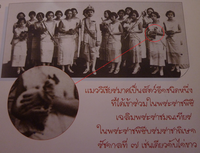

![While this show quality specimen from 1960 still exhibits relatively moderate characteristics, the breed standard was setting the stage for the modern Siamese, with its call for a "dainty, long and svelte" body, a long head that "taper[s] in straight lines from the ears to a narrow muzzle", "ears large and pricked, wide at the base" and tail "long and tapering".](http://upload.wikimedia.org/wikipedia/commons/thumb/3/3c/Siamese_cat_1960.jpg/200px-Siamese_cat_1960.jpg)


